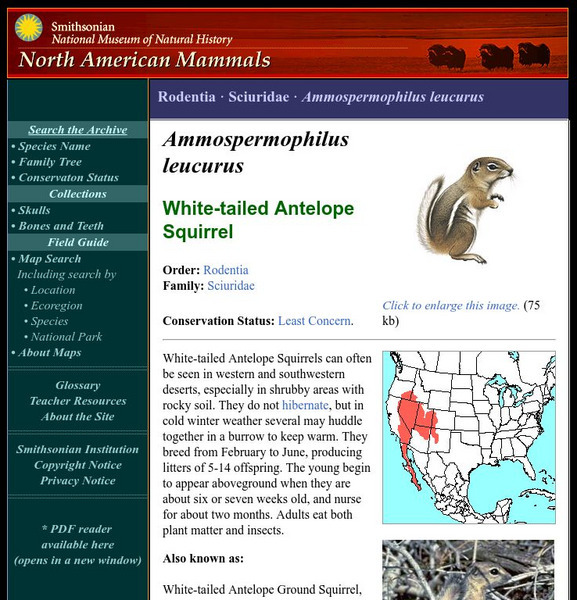Hi, what do you want to do?
Smithsonian Institution
National Museum of Natural History: American Mammals: Yellow Cheeked Chipmunk
Yellow-tailed chipmunks are common in California's dark, moist giant redwood forests. These relatively large chipmunks are hard to see but they can be recognized by a unique call given when intruders are present. Learn more about the...
Smithsonian Institution
National Museum of Natural History: American Mammals: Palmer's Chipmunk
Palmer's chipmunks live in a "sky island" mountains in southwestern Nevada surrounded by deserts the chipmunks cannot cross. They are common there, foraging where rocks or fallen logs provide cover. Learn more about the Tamias palmeri,...
Smithsonian Institution
National Museum of Natural History: American Mammals: Red Tailed Chipmunk
Red-tailed chipmunks sandbathe to clean their fur, rolling and rubbing, sometimes half-buried in sand. They are rarely seen outside their burrows on cold winter days, but in the spring they are out and about, eating seedlings, leaves,...
Smithsonian Institution
National Museum of Natural History: American Mammals: Panamint Chipmunk
Panamint chipmunks are named for the mountains in the Southwest where they were first collected by scientists, in 1890. As with many chipmunks, males and females look alike and are the same size. Learn more about the Tamias panamintinus,...
Smithsonian Institution
National Museum of Natural History: American Mammals: Sonoma Chipmunk
Young male Sonoma chipmunks disperse from the nest after weaning, but females remain near where they were born. From December through June, males travel extensively, seeking mates and competing with other males. Learn more about the...
Smithsonian Institution
National Museum of Natural History: American Mammals: San Diego Pocket Mouse
The San Diego Pocket Mouse occurs in desert and coastal habitats in southern California, Mexico, and northern Baja California, from sea level to at least 1,400 m. Yellowish or orange hair on its sides contrasts with a dark brown back,...
Smithsonian Institution
National Museum of Natural History: American Mammals: Townsend's Chipmunk
Clear-cut logging, which destroys habitat for some animals, offers good living conditions for Townsend's chipmunks. They find denning sites, cover, and food among the fallen, decaying logs and sprouting evergreens. Learn more about the...
Smithsonian Institution
National Museum of Natural History: American Mammals: Uinta Chipmunk
Uinta chipmunks are common in coniferous forests, especially at elevations higher than 1,800 m. They readily climb trees and shrubs to forage for seeds and often sleep in trees. Learn more about the Tamias umbrinus, more commonly known...
Smithsonian Institution
National Museum of Natural History: American Mammals: White Tailed Antelope Squirrel
White-tailed Antelope Squirrels can often be seen in western and southwestern deserts, especially in shrubby areas with rocky soil. They do not hibernate, but in cold winter weather, several may huddle together in a burrow to keep warm....
Smithsonian Institution
National Museum of Natural History: American Mammals: Red Squirrel
Red Squirrels are very vocal. They bark at intruders, including humans, and can bark continuously for more than an hour if they are annoyed. Learn more about the Tamiasciurus hudsonicus, more commonly known as a Red Squirrel, in this...
Smithsonian Institution
National Museum of Natural History: American Mammals: Wyoming Pocket Gopher
Wyoming Pocket Gophers are known only from a small area in south-central Wyoming. These rather small Pocket Gophers seem to prefer loose, gravelly, upland soils, often where greasewood is growing. Learn more about the Thomomys clusius,...
Smithsonian Institution
National Museum of Natural History: American Mammals: West Indian Manatee
West Indian manatees are big, slow-moving, gentle vegetarians. They live in warm, shallow water in coastal rivers, estuaries, and lagoons. Learn more about the Trichechus manatus, more commonly known as a West Indian Manatee, in this...
Smithsonian Institution
National Museum of Natural History: American Mammals: Polar Bear
Polar Bears prey mostly on Ringed Seals. In the spring, the pups are easy prey. Learn more about the Ursus maritimus, more commonly known as a Polar Bear, in this easy-to-read species overview by the Smithsonian's National Museum of...
Smithsonian Institution
National Museum of Natural History: American Mammals: Red Fox
Red foxes are the most widely distributed wild carnivores in the world, occurring in North America, Asia, Europe, and North Africa. They are also widespread in Australia, where they were introduced in about 1850 so that fox-hunters would...
Smithsonian Institution
National Museum of Natural History: American Mammals: Meadow Jumping Mouse
Meadow Jumping Mice have very long tails and very large feet. They are most common in grassy or weedy fields, where they use runways made by other rodents. Learn more about the Zapus hudsonius, more commonly known as a Meadow Jumping...
Smithsonian Institution
National Museum of Natural History: American Mammals: Western Jumping Mouse
Western Jumping Mice are common in meadows, streamsides, and marshes in northwestern mountains. They also occur in subalpine meadows, and are found at low densities in dry, low-elevation, grassy habitats. Learn more about the Zapus...




















